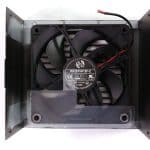Part Analysis
| General Data | |
| Manufacturer (OEM) | Andyson |
| PCB Type | Double-Sided |
| Primary Side | |
| Transient Filter | 4x Y caps, 2x X caps, 2x CM chokes, 1x MOV |
| Inrush Protection | NTC Thermistor SCK205R0 (5 Ohm @ 25°C) & Relay |
| Bridge Rectifier(s) |
2x GBJ2510 (700V, 25A @ 100°C)
|
| APFC MOSFETs |
2x Wayon WML53N60C4 (600V,26A @ 100°C, Rds(on): 0.07Ohm)
|
| APFC Boost Diode |
1x CREE C3D10060A (600V, 10A @ 152°C)
|
| Bulk Cap(s) |
2x Nippon Chemi-Con (420V, 560uF each or 1120uf combined, 2000h @ 105°C, KMR)
|
| Main Switchers |
4x Wayon WML28N65F2 (650V, 13A @ 100°C, Rds(on): 0.19Ohm)
|
| APFC Controller |
Champion CM6500UNX
|
| Resonant Controller | Champion CU6901VPA |
| Topology |
Primary side: APFC, Full-Bridge & LLC converter
Secondary side: Synchronous Rectification & DC-DC converters |
| Secondary Side | |
| +12V MOSFETs | 8x Infineon BSC014N04LS (40V, 125A @ 100°C, Rds(on): 1.4mOhm) |
| 5V & 3.3V | DC-DC Converters: 6x Nexperia PSMN4R0-30YLD (30V, 95A @ 25°C, Rds(on): 4mOhm) PWM Controller(s): ANPEC APW7159C |
| Filtering Capacitors | Electrolytic: 7x Nippon Chemi-Con (2-5,000 @ 105°C, KZE), 1x Nippon Chemi-Con (10,000 @ 105°C, LE) 4x Rubycon (6-10000 @ 105°C, ZLH), 1x Teapo (3-5,000 @ 105°C, TX) Polymer: 26x Polycap, 5x FPCAP 1x Nichicon HE |
| Supervisor IC | Weltrend WT7527 (OCP, OTP, OVP, UVP, SCP, PG) |
| Fan Controller / Micro Controller | Weltrend WT51F104 |
| Fan Model | Hong Hua HA1225H12F-Z (120mm, 12V, 0.58A, Fluid Dynamic Bearing) |
| 5VSB/12VSB Circuit | |
| Rectifier |
PJ335M
|
| Standby PWM Controller | Excelliance MOS EM8569C |
The platform is provided by Andyson and uses a contemporary design, with a full-bridge topology on the primary side, along with an LLC resonant converter for reduced energy losses. On the secondary side, eight Infineon FETs regulate the 12V rail, which feeds a pair of DC-DC converters that generate the minor rails. The build quality is good, and well-known parts are used everywhere except the primary side, where the APFC converter and the primary topology use Wayon FETs, which are not as known as Infineon ones. The soldering quality is not that good, with several messy soldering jobs on the PCB’s backside, and the PCB’s finish is generally not that good. This won’t affect performance and reliability; it is more an aesthetic issue for us picky reviewers.
The cooling fan is by Hong Hua, which dominates the PSU market, and for a good reason. It offers decent quality products at good prices. Because of the PSU’s compact dimensions, a 120mm fan was used instead of a larger one, which would offer the same airflow at lower speeds, reducing the average noise output.










































It is worth adding to the disadvantages only a 2-year warranty. That’s funny.
Nope, I won’t fall in the warranty pit ever again. Only if it is one year I will mention it.